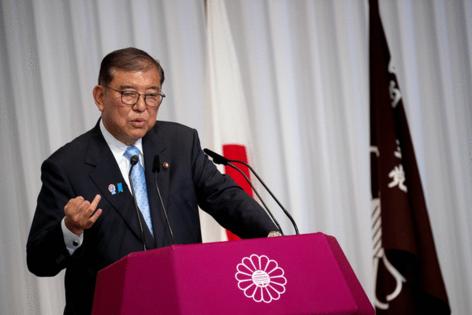Here's who could replace Japan's Ishiba if he resigns
Published in News & Features
Embattled Japanese Prime Minister Shigeru Ishiba is facing speculation that his days are numbered after facing a historic defeat in the upper house election on Sunday.
So far he’s denied local media reports that he will be resigning, but reports have said he could announce his resignation as soon as this month to take responsibility over the electoral losses.
Japan and the U.S. came to an agreement to cut the U.S.’s tariffs on Japanese cars and products more broadly to 15%, in a development that also leaves a clear path for Ishiba to step down. The prime minister had cited the trade negotiations as one reason for him to stay on.
“The party is ready to move on,” Tobias Harris, founder of Japan Foresight said on Bloomberg TV Wednesday. “But it’s not going to be an easy leadership election for the Liberal Democratic Party because they have a lot of challenges that the next leader is going to have to overcome.”
Those challenges include how to navigate concerns over looser fiscal spending, while somehow securing enough backing from opposition parties that have made demands for tax cuts and more subsidies.
A leadership election within the ruling LDP could yield a new Japanese prime minister if they can get enough opposition party support. On the other hand, the possibility remains for opposition parties to band together around someone outside the LDP, ushering in a non-LDP prime minister for the first time since 2012.
Here’s a look at the potential contenders to replace Ishiba.
Shinjiro Koizumi
The son of a former premier, Koizumi has been the face of the LDP’s policies to bring down the price of rice — a high-profile effort with huge cultural and political ramifications. As Farm Minister, Koizumi released emergency stockpiles of rice to wholesalers and succeeded in bringing down costs, winning approval among some of the populace, while alienating rice farmers. Koizumi was one of the final three candidates to run in the LDP leadership election last year, although he ultimately lost out to Ishiba. At 44, Koizumi would represent a new generation for the LDP, though some of his more liberal tendencies may turn off right-wing voters.
Sanae Takaichi
A former heavy metal drummer and hard-line conservative, Takaichi has cited former U.K. Prime Minister Margaret Thatcher as an inspiration. Takaichi narrowly lost to Ishiba in a runoff in the LDP’s leadership race last year, and she may have another shot at the top job if she can rally enough support within the party. If elected, she would become Japan’s first female prime minister, but like Thatcher her leadership would likely swing the country toward conservatism. A former minister for economic security, Takaichi is a frequent visitor to Yasukuni Shrine, a site regarded by Japan’s neighbors as a symbol of past militarism. Takaichi’s support for continued monetary easing and looser fiscal spending could also spook markets, pushing up government bond yields over fiscal concerns.
Yoshimasa Hayashi
Currently serving as Chief Cabinet Secretary and one of Ishiba’s closest aides, Hayashi would be a continuity candidate for the LDP. He’s often seen as closer to China than other party heavyweights, but has rejected the criticism he’s pro-China, saying he’s someone who prioritizes dialogue. The ruling party has frequently relied on Hayashi for damage control in the past. When previous administrations needed a replacement for short-lived ministers, Hayashi came in and calmed the waters, a record that he highlighted during his run in the LDP’s leadership race last year. Hayashi studied at Harvard University and spent most of the Kishida administration as foreign minister.
Takayuki Kobayashi
Young and conservative, Kobayashi was a longshot to assume leadership last year, but used that moment to plant himself in the minds of LDP members and voters. A former economic security minister, Kobayashi has recently been reaching out to Taiwan, and speaking about the importance of building supply chains that don’t rely on China. Kobayashi began his career in the Finance Ministry, and is a Harvard Kennedy School graduate.
Fumio Kishida
The former prime minister could make a comeback, after stepping down last year following a slush-fund scandal that engulfed the LDP and ultimately triggered a wide-open leadership election. Local media have reported his interest in taking another shot at the top job, but the LDP may find it difficult to present itself as a revamped party if it goes back to Kishida for representation.
Katsunobu Kato
Finance Minister Kato didn’t get much support in the September LDP leadership race, but the fact he has good relationships with both conservatives and reformists within the party can boost his appeal as a leader who can bring lawmakers together. A former Finance Ministry official, Kato has played key roles under the last three premiers. He served as the government’s top spokesperson and helped guide Japan through the Covid-19 pandemic as health minister. In his role as Finance Minister, Kato has held talks with U.S. Treasury Secretary Scott Bessent and managed to separate out discussions on currencies from the main trade talks.
Yoshihiko Noda
The former prime minister led his Constitutional Democratic Party of Japan to its best ever lower house election result last year, and had a moderately successful upper house election. But he faces an uphill battle to form a patchwork coalition government to replace an LDP-led administration. With 148 seats in the more powerful lower house, Noda would need every scrap of support he can get to reach the 233 seats needed for a majority. That would likely require substantial compromise with other opposition parties including the Japanese Communist Party.
Yuichiro Tamaki
The election result last year has made Tamaki, the leader of the Democratic Party For the People, a key player deciding the fate of an LDP-led ruling coalition. The opposition party sharply increased its seats in both the upper and lower house in recent elections, campaigning on a promise to increase take-home pay. Analysts continue to say teaming up with DPP is among the more plausible options for the LDP and its junior coalition partner Komeito to secure a majority in parliament. The LDP has a precedent for choosing to back a non-LDP member for the nation’s leader: In 1994, the LDP and its coalition partners installed Tomiichi Murayama, a social democrat, as prime minister.
Sohei Kamiya
The leader of Sanseito, a five-year-old party that’s made a surprise leap ahead in the upper house election under the slogan of “Japanese First” and promises to make people rich, Kamiya’s message has echoes of U.S. President Donald Trump. After Sunday’s vote Sanseito has suddenly increased its upper house seats from one to 15, but given how radical some of its proposals are, it’s unlikely that Kamiya will make any headway as candidate for Japan’s national leadership.
©2025 Bloomberg L.P. Visit bloomberg.com. Distributed by Tribune Content Agency, LLC.







Comments